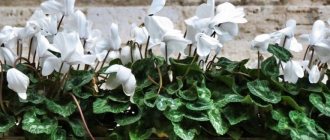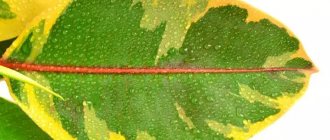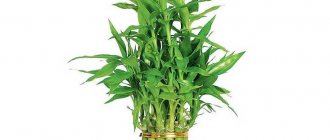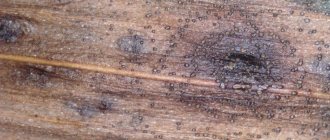You can often hear complaints from beginning flower growers that for some reason the leaves of cyclamen are fading and turning yellow. As a rule, the unhealthy appearance of a plant is due to improper care. To help the flower recover, it is usually enough to change the conditions to more suitable ones.
In the most favorable situation, yellowing and wilting of the green mass may be a consequence of the gradual transition of cyclamen into a dormant period; in this case, proper rest should be properly organized for it. It is much more dangerous if the leaves turn yellow as a result of disease or damage by insect pests. Therefore, it is necessary to identify the cause extremely carefully, taking into account all the factors that may affect the condition of the flower. Then it will be possible to choose the right tactics to help the plant and not delay in providing it.
Maintenance during the rest period
Cyclamen has faded, what should I do next and how to care for it after flowering?
After flowering (late spring), cyclamen begins a dormant period. There are several options for keeping the plant at this time. ATTENTION: As soon as the leaves begin to turn yellow, reduce watering, not allowing the earthen coma to dry out. The pot with the tuber is placed in a shaded, cool place. Another option for home care to preserve the tubers: after flowering, watering is reduced, and when all the leaves fall off, the pot with the plant is laid on its side
The roots do not die and, in order not to dry out the soil, cyclamen is sometimes watered
Another option for home care to preserve the tubers: after flowering, watering is reduced, and when all the leaves fall off, the pot with the plant is laid on its side. The roots do not die and, in order not to dry out the soil, cyclamen is sometimes watered.
After the cyclamen has gone to rest, its bulb cannot be stored in the refrigerator. Otherwise, after the end of the rest, he may not wake up. In order for cyclamen to come out of its “vacation” again, you just need to put it in a dark place, such as a balcony, basement, or simply put it under the bathroom.
During dormancy, it is recommended to water the plant no more than once every 2 weeks. Watering should be done with warm water containing phytohormones, and avoid getting it on the flowers, leaves and bulbs.
Watch a video about caring for cyclamens during the dormant period:
Preventive measures
To prevent the plant from withering or other negative consequences, it is worth taking preventive measures, or knowing how to properly care for this variety of indoor flowers:
- The room where the plant is located should be cool. If the room temperature is kept within +6...+12°C, then cyclamen can bloom for up to six months.
- The lighting should not be too bright; it is better to try to keep it diffused.
- The soil needs to be prepared loose, with a weak reaction and good drainage, for example, ready-made soil is suitable for plants such as violets.
- Do not select a large and deep pot.
- Replanting cyclamen is done once every 2-3 years, and the container should be chosen larger than the previous one.
- Planting depth will depend on the type of plant.
You should not bring the flower to a state where it requires emergency help. In order for cyclamen to grow and bloom normally, it is necessary to fulfill a minimum number of requirements for caring for it. If you follow all the rules, then cyclamen will grow on average for another 15 years and delight your household with its lush flowering.
If you find an error, please select a piece of text and press Ctrl+Enter.
https://myorchidea.ru/tsiklamen/pochemu-vyanet/https://pocvetam.ru/komnatnye-rasteniya/tsvetushchie/kak-spasti-tsiklamen.htmlhttps://selo.guru/rastenievodstvo/derorativ/tsiklamen/zabolevaniya/ vyanet.htmlhttps://dacha.expert/domashnie-rasteniya/tsvetushhie/tsiklamen/bolezni-tsik/vyanet-tsik.html
vote
Article rating
Why does withering occur?
It is very important to learn how to choose the right flower when purchasing in order to avoid troubles in the future.
First of all, it is necessary to pay attention to the condition of the tubers. It is better to refuse the purchase if they are damaged
At the same time, the presence of rot on the roots is unacceptable. The tubers should be smooth in shape, and the leaves of the plant should not look sick.
When it comes to diseases of indoor plants, they are conventionally divided into parasitic and non-parasitic. In the first case, we are talking about the harm of parasites, in the second, about improper care of the flower.
Factors in the development of non-parasitic diseases are:
- excess moisture in the soil (learn how to save flooded cyclamen here);
- lack of air humidification in the room where the plant is located;
- incorrect choice of soil;
- inappropriate pot size;
- incorrect choice of location for the plant.
As for parasitic diseases, it is necessary to mention such pests as aphids, cyclamen mites and thrips:
- Aphids are among the most common parasites. It leads to complete deformation of the leaves and the plant, contributes to its depletion, taking away all the juices. Symptoms of the presence of aphids are white, gray, black, green or orange coating on the leaves of the flower. In order to eliminate aphids, you should spray cyclamen with an insecticide and then rinse it with jet water.
- Thrips are highly active. They are very bright and it is not difficult to identify them. They leave traces of their presence, which have a silvery tint. This inhibits the further growth of the leaves of the flower, as a result of which they may simply fall off. In order to eliminate thrips, you can use sticky tapes or insecticides.
- The cyclamen mite is microscopic in size, so it is very difficult to notice it on a flower. It parasitizes on the inside of the leaf. From the outside it seems that the leaves are covered with dust. The main difference is that it is very difficult to shake off such dust, and the edges of the leaves begin to curl. You can get rid of the parasite using chemical antiseptics.
Features of growth
Two types of cyclamen are most often used as a house plant - European and Persian. To grow any of them you need to work hard, since the alpine violet is very picky. Often, beginning gardeners complain that the flower quickly turns yellow and withers. To prevent this from happening, you need to know about plant care from the very beginning, that is, from choosing a flower when purchasing it.
First, take a close look at the tubers. They should be free of damage and rot, they should be smooth, and the leaves should be shiny and bright. If cyclamen foliage is limp or dried out, this indicates a flower disease. Therefore, buy a flower in the autumn, when there is already flowering and you can determine whether the plant is healthy.
When you bring a flower home, you need to know how to properly care for it. Otherwise, it will lose its former appearance, the leaves will begin to turn yellow or wither. The temperature in the room plays an important role. So, if you notice yellowed edges on the leaves, it means the air in the room with the flower is too dry. This means you need to increase the humidity in the room.
For a flower, the maximum comfortable temperature is 17 ºС, no more. Alpine violet does not tolerate direct sunlight or lack of moisture. These factors affect the inflorescences, flowering becomes rare and not so lush. If watering is regular and fertilizing is frequent, then cyclamen will delight you with its flowers again and again.
What to do in this case?
First, you need to pinch off yellowed and dried leaves at the base, as well as dried flowers. In this case, you cannot use a knife or scissors; this can lead to further progression of cyclamen disease.
Advice! In order to preserve the plant, it is necessary to create the most favorable conditions for it.
If heating devices are used in the room, it is recommended to move the plant away from them. You should also avoid direct exposure to the scorching sun. On hot days, you can cover the flower tubers with ice. During the hot period, alpine violet will feel much better in a shady corner. If it happens that the cyclamen has been standing in the sun for a long time, then you can place the pot in a basin with cold tap water for 1-1.5 hours. This way the flower can be revived.
Sometimes cyclamen begins to turn yellow and dry out due to infection (read about the causes and treatment of cyclamen with yellowed leaves here). To get rid of the Fuzarium fungus, it is recommended to water the ground with a 0.1% solution of foundationazole or spray the plant with a 0.1% solution of a drug such as Topsin-M.
Wet rot can also lead to wilting, causing the plant to smell foul. Bacteria enter through cracks in the tubers. Quite often, infection occurs through the places where leaves are torn off. Sometimes infection can also occur through contaminated water or soil. A flower damaged by rot can be treated with an antiseptic, for example, crushed coal. In addition, the plant must be watered with settled water. In a situation where the infection was transmitted from another diseased plant, cyclamen cannot be saved. All that remains is to destroy the flower.
Natural causes
Sometimes it happens that cyclamen withers for completely natural reasons, that is, it enters a dormant period, which begins with the fact that the flower simply stops blooming. Gradually, the leaves of the alpine violet turn yellow, and then the entire above-ground part of the plant withers and dries out. During this period, it is recommended to gradually reduce the intensity of watering the flower.
After it has completely dried, the flower should be moved to a cool and shaded place. The plant will remain in this state for several months. After the woody plant begins to produce young leaves, it needs to be moved to a bright place and watered regularly.
It happens that the plant looks already withered and dead, in this case you can try to revive it. You should remove the rhizome from the ground and look at its condition. Even if the small roots have died, you need to feel the tuber - it must be elastic, otherwise the plant cannot be helped. It is necessary to wash the rhizome from the soil and treat it with a fungicide, for example, Topaz. Then dry it (for a short time) and plant it again in sterilized soil.
Important! The main thing is not to be late and then, perhaps, your flower will find a second life.
More information on how to save cyclamen when it dies can be found here.
So what to do if cyclamen turns yellow?
If the leaves of cyclamen begin to turn yellow, it is necessary, first of all, to inspect the plant for the presence of diseases or pests. It is worth carefully examining the surface of the tuber. If there are signs of rot, the tuber is pulled out of the ground, cleaned, and damaged roots are removed. The plant is carefully treated with a fungicide - a drug that destroys bacteria and fungal spores. The tuber is placed in different soil.
Rot can result from improper watering of the plant. Cyclamen loves frequent watering, especially during flowering. But they shouldn't be plentiful
Particular attention should be paid to the following point: water should not get on the tuber and growing point. If green or mold or an unpleasant, musty odor appears on the surface of the soil, the plant must be urgently transplanted into another soil. If cyclamen leaves turn yellow, the reason may lie in the presence of pests on the plant
If cyclamen leaves turn yellow, the reason may lie in the presence of pests on the plant.
Insecticides are used to eliminate them. These are chemicals designed to kill insect pests.
Why do cyclamen leaves turn yellow during flowering?
During flowering, cyclamen requires increased attention.
This is especially true for nutrition, because it is vital for the plant to receive all the necessary substances during this period. For this, complex fertilizers are best suited, capable of providing the flower with all the necessary elements. . They must be used strictly according to the instructions, while being guided by the principle “Do no harm”
Improper use of such drugs and an excess of fertilizer in the soil can cause an effect completely opposite to the expected one. With proper care, most often the question of what to do if the cyclamen turns yellow disappears by itself
They must be used strictly according to the instructions, while being guided by the principle “Do no harm.” Improper use of such drugs and an excess of fertilizer in the soil can cause an effect completely opposite to the expected one. With proper care, most often the question of what to do if the cyclamen turns yellow disappears by itself.
On hot days, if there is dry air, you can place the pot with cyclamen on a tray with small pebbles or peat. It is necessary to ensure that the tray is constantly moist. You can use small fountains or humidifiers. It is not recommended to spray cyclamen on the leaf. On sunny summer days, it is better to shade the windows and avoid direct rays hitting the flower.
These simple rules will help you avoid yellowing of cyclamen leaves during flowering and the growing season. All the troubles are completely worth it with the amazing beauty of this plant.
In this video you can learn more about cyclamen and the features of its care at home. Don't forget to ask and discuss.
Reproduction
Persian cyclamen can be propagated by seeds or by dividing the tuber. The latter method is very traumatic and is rarely used at home. Many plants sold in stores are hybrids, and their pollination results in the splitting of traits in the offspring - in other words, the likelihood of getting the same cyclamen from seeds is very small. To ensure that varietal characteristics are preserved, it is best to purchase them from a reputable seed producer. Seeds should not be expired.
To obtain seeds at home, it is better to have several copies, and during flowering, use a soft brush to transfer pollen from one flower to the stigma of another, providing artificial pollination. After pollination, the peduncle twists and carries the seed box closer to the ground. Seed ripening lasts several months; it is better to sow them immediately after opening the box. Young plants that are different from each other and from their parent specimens can grow from seeds.
You can sow seeds at any time of the year, but it is better in early spring. It is useful to pre-soak the seeds in Epin according to the instructions for the preparation. The soil for sowing must be sterile (steamed) to reduce the likelihood of rot, and consist of sand and a ready-made peat mixture. You should not add humus to the soil, as it contributes to the further development of fungal diseases. For sowing, shallow boxes or other containers are usually taken; the seeds are planted in grooves about 1 cm deep at a distance of 2-3 cm from each other. It is better to pre-dild the grooves. The distributed seeds are carefully embedded in the soil, and the top is soaked with a fine sprayer so as not to wash out the surface.
Germination occurs in the dark, so the containers are covered with black film, leaving a gap of several centimeters from the ground level. The film will help prevent the soil from drying out too quickly. Germination temperature +18…+20оС. It is necessary to monitor the soil moisture and periodically ventilate the crops. Shoots appear in about 30-40 days, some varieties take longer to germinate. As soon as the shoots appear, you need to remove the dark film and transfer the containers with the seedlings to bright, diffused light, the temperature should be maintained within the same limits.
At the stage of 2-3 leaves, cyclamens dive, preferably one at a time, by this moment they are already growing small nodules above the ground (under the cotyledon leaves), they should be completely covered with soil. After 6-7 months, cyclamen are planted in small pots (about 6 cm in diameter), the tubers are left open by about 1/3. In the first year of life, young plants do not rest; with good care they can bloom at the age of 15-18 months, but usually the first flowering occurs closer to two years.
Persian cyclamen is rarely propagated by dividing the tuber; these cyclamens do not produce children, so the mother tuber has to be cut. In this case, there is a high probability of rotting of the divided tuber. Only old specimens that have been growing for several years are suitable for this procedure. Imported plants are usually not divided in the first year.
You need to wait until all the leaves have completely died off, carefully remove the tuber from the pot and free it from the old soil. Place on the table and cut from top to bottom in the center with a clean sharp tool so that each part has leaf buds and roots. Treat the sections with fungicides, sprinkle with coal, and let dry. Plant in different pots in the usual order.
What kind of plant is this?
The genus Cyclamen or Alpine violet from the Myrsinaceae family, sometimes attributed to the Primulaceae family and includes about 20 species. In fact, the correct name of the plant involves stress on the first syllable - cyclamen, and the generally accepted pronunciation comes to us from the French language.
The genus Cyclamen includes such plant species as perennial herbaceous plants, common in the Mediterranean countries; from Spain in the west to Iran in the east, as well as in Northeast Africa, including Somalia. Cyclamen is a perennial corm plant with beautiful patterned heart-shaped leaves and single flowers on long stalks. The flowers, up to 8 cm in diameter, have five petals and can be white, pink, purple, lilac and even violet.
On a note. Cyclamen leaves grow directly from the root, and pedicels appear from there, making the plant look like a lush bush.
Among the domestic species of cyclamen, varieties with green carved leaves are distinguished, on which an intricate pattern of light green color is visible.
Further care at home
If the cyclamen has faded, what to do next at home and how to care for it? Caring for cyclamen after flowering means proper watering and maintaining the right temperature.
You should pay attention to care during the dormant period, when the daytime temperature reaches 20°C. This period lasts from mid-April to September, during which time cyclamen does not bloom, its leaves dry out and fall off
Proper watering
It is enough to water the flower once a week; before the next watering, the top layer of soil must dry completely. After watering, the soil should be moist, but not soggy. You can only use purified or settled water.
Watering from a watering can
If the cyclamen has faded, what needs to be done next and how to water it:
- During the dormant period, watering is not stopped, it is reduced to 2-3 times a month;
- Water the plant with a small amount of water, depending on the size of the pot;
- After 2 months of rest, the amount of water is gradually increased in order to return to normal by the time of flowering.
Note! Cyclamen requires sufficient air humidity; in addition to watering, the plant should be periodically sprayed with water.
Feeding and fertilizers
For active growth and lush flowering, the plant needs to be fertilized.
Features of feeding cyclamen:
- For an adult flower, fertilizing is carried out 1-2 times a month until the buds form. As a fertilizer, you can choose liquid fertilizer “Floretta”;
- At home, you can prepare your own fertilizer by mixing 2 liters of water and 6 tbsp. l. wood ash;
- If the plant is young and still growing, you can feed it with calcium nitrate;
- It is better to minimize the use of mineral compounds; cyclamen does not tolerate high concentrations of salts;
- The use of chloride fertilizers is not allowed;
- Fertilizer should be applied only to moist soil;
- It is undesirable to use complex fertilizers for deciduous plants, otherwise foliage will begin to actively grow instead of buds;
- After flowering, all fertilizing must be stopped.
Note! If cyclamen was grown from seeds, it must be fed with growth activators immediately after the formation of the first shoots
Lighting
Cyclamen is a light-loving plant; it needs bright, diffused lighting. It is advisable to avoid direct sunlight, as this will cause the leaves to dry out and fall off. The plant can stand near a window on the east, west and southwest sides. In the morning and evening, it is allowed to place the flower on the windowsill near the south window.
Pots on the windowsill
Note! During dormancy, the plant gets used to the darkness; you cannot immediately place it in a lighted place. Cyclamen should stand in partial shade for 3-4 days to get used to the light again.
Temperature
One of the common questions from indoor flower owners is “If the cyclamen remains in the pot after flowering, what should you do with it and at what temperature should you store it?” The plant feels good at daytime temperatures from 10 to 18°C and night temperatures within 6-9°C. During the heating season, cyclamen should be kept away from radiators and heaters.
During the dormant period, the flower should be kept indoors at a temperature of 15-20 ° C; it can be stored in basements, cellars or in an air-conditioned room. If in the hot summer it is not possible to provide the required temperature, storage in the refrigerator is allowed. The plant is dug out of the soil, the roots are wrapped in polyethylene and placed in the lower section for storing vegetables.
Primroses require special conditions; in unfavorable conditions, they will not bloom. If the leaves of cyclamen quickly turn yellow, or the plant looks sick, it is necessary to immediately provide assistance. Incorrect or untimely actions can ruin the flower.
What kind of flower is this?
ATTENTION: In specialized sources, this plant is called Alpine violet due to its wide distribution in the Alps. People often call the flower “pork bread” or “dryakova”
The homeland of cyclamen is the Mediterranean coast (countries of Southern Europe, Central Asia).
Among the features of the plant are rich green leathery foliage, a decorative silver pattern on its surface, the original shape of the flowers and fringed petals. The color palette is extensive: from snow-white hybrids to burgundy flowers. The flowering period reaches 3 months. At home, cyclamen blooms in autumn or spring.
This is interesting: European cyclamen - description, properties and care rules
Varieties
Currently, 20 varieties of cyclamen are known, but the most common among domestic flower growers are the Persian variety of cyclamen and the European species.
A characteristic feature of the Persian variety is the almost constant flowering of the plant, while the European cyclamen blooms less at home, however, thanks to the beautiful heart-shaped leaf, it has also found its fans.
Persian cyclamen is often called alpine violet. This is a fairly large indoor flower, reaching 30 cm in height. This species is characterized by large buds of purple, white or pink. The flowering period begins in autumn and ends in spring; in summer the flower rests.
European cyclamen is characterized by the presence of beautiful green leaves all year round. The buds of this variety are smaller, pale pink in color and have a very delicate aroma.
Growing this variety of cyclamen is not particularly difficult, so experts recommend it to all beginning gardeners.
Improper care as the cause of yellow leaves
Persian and European cyclamens are most often grown at home. The flowering period of these varieties begins at different times: the European one begins to bloom in the warm season, and the Persian one, starting in October.
Temperature
If yellowing of the leaves occurs while maintaining the freshness of the buds, then you should pay attention to the temperature in the room. The optimal temperature for this flower is 12-15 °C. If it drops below 10 °C, the plant may die
However, if the regime has crossed the upper limit, the leaves begin to turn yellow, dry out and fall off. It is recommended to take the flower pot to a cooler room and away from the central heating radiators.
Flowering cyclamen leaves turn yellow most often due to the temperature in the room
Humidity and lighting
Compliance with the conditions will allow you to grow a beautiful flower. To do this, humidity must be within 50%. If it rises to 80%, then there is a risk of infection with cyclamen mites, and if it is low, it leads to the appearance of red spider mites. You can save the plant in the following way: you need to spray water near it from a small spray bottle, but in such a way that it does not fall on the flower itself. You can increase air humidity using wet expanded clay, which can be poured into the tray of the pot.
Note! The flower should not be in a draft, but it is worth making sure that there is good air circulation in the room with it. In this case, you can place the pot with the plant closer to the wall
There is enough natural light for the flower. Cyclamen loves soft, diffused light. When the leaves are exposed to direct sunlight, they begin to turn yellow and can get burned. In summer, it is worth keeping the flower on the east side, and in winter, move it to the south.
Watering
Cyclamen loves moist soil, but you should know certain nuances:
- water should be at room temperature;
- it is necessary to water the flower regularly;
- do not allow drops to fall on the tuber and leaves;
- the water should stand for at least 24 hours;
- It is worth watering slightly dried soil;
- It is necessary to drain the water from the pan after watering.
If the soil is always too wet, the roots may begin to rot and mites may develop. However, cyclamen also does not like dry soil and reacts to it by yellowing of the foliage. If it becomes overwatered, it is worth replanting the flower in a new pot.
Damage to cyclamen disease
Why does cyclamen shed its leaves, how to save the plant from death?
Cyclamen can shed its leaves for several reasons. You can understand whether this is a reason for concern if you carefully observe the flower. If it begins to turn yellow and wither slowly, and then just as slowly gets rid of old leaves, then it’s time for a seasonal rest. In this case, there are no health problems.
Cyclamen leaves turn yellow
If the branches become bare in a matter of days, it means the plant is sick. Why is this happening? The cause may be improper care or parasite infection. In any case, you should not despair: timely treatment will give a positive result.
Inadequate care during and after flowering
Northeast Africa is considered the birthplace of cyclamen. The sunny, humid climate of this part of the world allows the flower to grow to incredible sizes and bloom profusely. However, it is incredibly difficult to recreate ideal conditions in an ordinary apartment. If this fails, the plant turns yellow and sheds its leaves. In this case, you need to analyze what exactly could upset the plant so much. It could be:
air temperature is too high or low. Cyclamen prefers to grow and bloom at home at 12 - 17 degrees above zero. In winter, it feels great on glazed balconies, but during severe frosts it is better to bring it indoors.
improper watering. Most cyclamen varieties have a moderate appetite. They should be watered about once a week, when the substrate is almost completely dry. It is necessary to ensure that the entire earthen lump is moistened without turning into a swamp. Drought is also detrimental to the flower. The soil in a pot with cyclamen should not be allowed to remain dry for several days;
Cyclamen should be watered once a week.
- direct sunlight. Cyclamen loves diffused light. Rays falling directly on the delicate leaves of a flower can cause burns. The result is yellowing and falling off;
- lack of nutrients. Special fertilizers must be applied regularly: after transplanting into a new pot, once every two weeks, after the appearance of buds, once a month.
Natural process
Cyclamen is a cyclical plant. After flowering, which can last for several months, it goes into retirement. At this time, its leaves also begin to turn yellow and dry. They must be removed by unscrewing them at the base.
The fallen flower is either left in the pot or the tuber is dug up. In the first case, the plant is moved to a cool, shaded place and watering is severely limited.
Cyclamen tuber after flowering
In the second, the onions are cleaned and stored in a dry, ventilated place at a temperature of 10-25 degrees above zero. They are planted in a new substrate in late summer - early autumn.
Cyclamen can also get sick and shed its leaves due to changes in its life: after transplanting or moving to another place. If the new conditions meet the needs of the plant, then all that is required of the owner is to remove the yellowed leaves and wait until the flower comes to its senses. Of course, without ceasing to carefully care for him.
Plant pests
Yellowed cyclamen leaves may indicate that pests have appeared in the flower pot. How to recognize who exactly is preventing the plant from living when it begins to disappear and what to do to revive it can be found in the table.
| Fungi | Fusarium | The plant turns yellow and dries out gradually, the process begins from the tops of the leaves. | The flower is taken out of the pot, cleaned, the affected areas of the tuber are removed, treated with a fungicide and planted in fresh calcined soil. |
| Gray mold or Botrytis | First, a gray coating appears on the leaves, and only then they begin to quickly turn yellow. | The affected areas are removed with a sharp blade and the entire plant is treated with a fungicide. | |
| Erwinia | The leaves turn yellow and die very quickly. | The affected areas are removed with a sharp blade and the entire plant is treated with a fungicide. | |
| Ticks | Red tick | A cobweb forms on the underside of the leaves, then the plant turns yellow. | The affected leaves are removed, and cyclamen is treated with an insecticide. |
| Cyclamen mite | The damage process begins with leaf deformation. Having changed shape, they turn yellow and fall off. | All means are powerless, all that remains is to destroy the plant. | |
| Viruses | Bronzing of leaves | The leaves first become deformed, then turn yellow and dry out. | Treatment is impossible. The flower must be destroyed to prevent infection of other plants. |
| Ring mosaic | Round light spots form on the leaves, which then crack and turn into holes. |
Diseases
Some diseases can turn your little cyclamen into a bush with yellowing leaves and wilting flowers. Diseases affect the plant during the growth period - in winter. Most of them cannot be treated, and gardeners recommend throwing away the diseased plant before the disease spreads to healthy ones.
Fusarium wilt
Fusarium rot causes rapid wilting. It immediately attacks the roots and moves through the xylem of the plant. It is very specific; certain types of fusarium rot infect only cyclamen. Therefore, pots after flowers that have been exposed to this disease must be disinfected or replaced with new ones.
Conditions for its appearance: very warm air with a temperature of +23–35° C and excessive humidity (75–80%). Rot bacteria may be present in the soil but not appear as long as the soil is dry. The first symptom of fusarium rot is that cyclamen leaves turn yellow and wither.
Remove the plant from the pot and inspect the roots. If you cut the stem or tuber of such a flower, you will see that it is colorless inside. Discoloration is a sign that a flower must be thrown away, just like those that were next to it. Before planting the tuber, use fungicides labeled “Against Fusarium rot.”
Gray rot
Gray mold is caused by the fungus Botrytis, which appears when the center of the plant is over-watered. Additionally, insufficient air circulation creates an optimal environment for the development of the fungus. This type of rot develops at the base of stems and quickly attacks flower buds and leaves. All affected parts should be removed and discarded, and the plant should be moved to a room with better air circulation. If the flower is heavily infected, it is better to throw it away.
Important! Tubers contain various substances, including saponins - plant poisons. They can cause poisoning, so keep cyclamen away from children. The degree of poisoning depends on the amount ingested
The degree of poisoning depends on the amount taken orally.
To improve air circulation, you can install a fan after removing all damaged parts of the cyclamen. Try to avoid getting water on the leaves or crown when watering. Erwinia bacteria are responsible for soft rot. The cyclamen turns yellow, the leaves fade, and the tuber becomes soft. This problem occurs if the tubers are planted too deep and the soil mixture contains a lot of moisture, a lot of heat and a lot of fertilizer. It is also better to throw away the affected plant.
Wood ash can prevent gray rot. But if the plant is severely affected, then fungicides are used. "Fitosporin M" is a natural bifungicide that contains the bacteria Bacillus subtilis. Developing in the soil, they destroy pathogenic microflora, including bacteria that cause gray rot. The drug not only treats, but also improves the condition of the soil and increases the resistance of cyclamen to diseases. If you purchased the drug in liquid form, you do not need to dilute it. Use according to package instructions.
Pests
Pests can also cause yellowing leaves. Most of them enter the room with the help of the wind, as they have wings. But they can be brought from the store along with a new plant. Cyclamen is susceptible to common insect pests of houseplants. They all cause varying degrees of damage.
Among the main ones:
- spider mite;
- aphids;
- scale insect;
- thrips.
Did you know? During the Renaissance, cyclamen was considered a remedy for ear pain, as the shape of the petals resembles the auricle.
Thrips
Thrips are tiny brown or black insects with a long body and wings tucked to the sides. Their shape is close to cylindrical, for which thrips were previously called “bottle-footed”. They live on the underside of leaves, so they are hardly noticeable. Thrips cause double damage: they suck the juice and bacteria settle in the areas that were affected by the insect, causing various types of rot. The problem with eradicating thrips is that they are too small and move too quickly. The main control strategy is to limit their number.
Distinctive symptoms of infection:
- Thrips are very small and the first thing you will notice is a light yellow powder on the leaves. This is pollen that is shed when insects feed on flowers.
- Light stripes appear on the underside of the leaves. They occur in places where the leaf is damaged.
- The leaves darken along the edges.
- There are a lot fewer flowers than before. Holes form on the petals.
For treatment, dissolve 1 ampoule of Actellik insecticide in 1 liter of water and spray the plant with it. Then wrap it in a plastic bag for a day to prevent thrips from flying to other plants. The death of insects will occur within a few hours, but just hold the bag a little longer to make sure of this. Repeat treatment after 7 days.
Shchitovka
The scale insect is a small insect from the hemiptera family that feeds on plant juices. It looks like a small waxy spot located on a leaf. The insect's body is covered with a dense shield, so most insecticides do not affect it. More than 2000 species of scale insects are known. Insects can get into the house along with store plants or the wind.
Distinctive signs of infection:
- yellowing deformed leaves;
- sticky discharge on leaves.
A plant affected by scale insects must be rearranged separately from others and the insects must be removed manually. They need to be removed with a soft toothbrush dipped in an insecticidal soap solution. After a few days, the treatment is repeated.
Ticks
The cyclamen mite is a tiny arachnid insect, invisible to the naked eye. If you examine an infected plant under a microscope or magnifying glass, mites are insects with 8 legs that are brown, white or yellow. They live among foliage, where there is little light. Mites appear when relative humidity drops below 50%.
Main symptoms of infection:
- cyclamen leaves curl along the edge; although this symptom can also be caused by aphids, aphids are clearly visible, unlike mites;
- leaves turn pale or yellow, especially young ones;
- dark spots appeared on the leaves at the bottom;
- the edges of the leaf become brown;
- kidneys do not open;
- flowers become stained and deformed;
- the plant slows down its growth.
Treatment consists of isolating the infected plant.
Treatment is carried out with acaricide by spraying. The solution is prepared in strict accordance with the instructions on the package. Since the next generation of mites will become active 6 days after laying eggs, the treatment is repeated up to 4 times with an interval of 4-5 days between them. The crown of the plant must be treated especially carefully. Maintaining normal indoor humidity (60–65%) can prevent the appearance of mites. You can treat the plant with insecticidal soap in the early stages of infection. But if the plant is heavily infected, it is better to simply abandon it.
Find out what and how to feed indoor plants at home.
Aphid
Aphids are small green insects with a pear-shaped body, long antennae and legs. Some species of aphids have wings. They can also be of other colors (brown, black), but most often aphids are green. Insects cluster on the underside of cyclamen leaves.
Distinctive symptoms of infection:
- insects leave behind a sticky coating on the leaves, later fungi appear on it;
- the appearance of aphids is familiar to many, so diagnosing their presence is not difficult;
- the leaves curl along the edges, become pale, turn yellow and wither.
Begin treatment by isolating and treating the plant with a soapy solution.
Gently wipe with a cloth soaked in a solution of insecticidal soap the areas where sticky deposits appear and where aphids accumulate. If fungus appears on the leaves, remove the infected parts of the plant. Cyclamen can also be treated with Malathion (1 teaspoon per 4 liters of warm water). It is a broad-spectrum insecticide and acaricide that can be used against any sucking insects. But since insecticides can discolor leaves, start treatment by using soap solutions. There is no reliable way to prevent aphids. Therefore, just monitor the signs of their appearance.
Did you know? Each type of cyclamen is susceptible to infection only by certain types of aphids.
There are many reasons why cyclamen leaves turn yellow, but all of them can be easily eliminated if you maintain the right microclimate and monitor the appearance of pests. This can be done using special traps. Then you will not only recognize the problem in time, but also quickly fix it.
Options for flower resuscitation
It is possible to revive and save a flower only in the early stages of damage, when there are no serious deformations of the stem and foliage.
Leaf with pests
What you need to do to preserve cyclamen:
- Determine the disease and its cause. For example, the problem is stagnant moisture, poor-quality soil or high temperature;
- Remove damaged parts of the flower: leaves, stems, damaged roots;
- The surviving parts are treated with a solution, the choice of which depends on the disease of the plant;
- If the problem is in the soil, replanting into a new high-quality substrate will be required;
- The plant continues to be looked after, watering, temperature and lighting are controlled.
If cyclamen leaves curl due to pests, the problem must be eliminated.
You can fight pests with folk remedies or insecticides, which is better to use:
- Chemical agents will help get rid of aphids: Aktara, Fitoverm, Agrovertin. The leaves are treated with a cotton swab dipped in the solution, after which the plant is washed in the shower;
- When choosing chemical preparations, it is necessary to take into account that mites are not insects, and conventional means will not help. Acaricides Neoron and Sunmite will help to overcome the pest;
- Solutions of Aktara, Fitoverm and Bankol, which need to be used to treat the leaves, will help get rid of scale insects. Adults have the ability to fly to different bushes, so treatment is carried out every 14-30 days;
- In the fight against thrips, it is better to prevent their appearance. It is necessary to maintain normal humidity and air temperature, especially in summer. If insects are infested, the chemicals Akarin, Fitoverm and Agrovertin will help get rid of them.
Young flowers do not rest in summer and bloom profusely; for adult plants, rest in the hot season is of great importance. If you do not give cyclamen a rest, natural rhythms are disrupted. To make cyclamen bloom next season, you need to get rid of problems and properly care for it.
Transfer
It is better to do this in the summer, but only with the onset of the active phase. At the end of spring, flowering stops and a resting phase begins. At this time, watering is stopped, and the flower pot is placed on its side. Watering is resumed by July. With the appearance of the first leaves, the flower is replanted.
The pot should be much tighter for the tuber. It does not need to be buried to its full height. It should rise one third above the ground surface. There is no need to water the flower abundantly after replanting. The lump of earth in the pot should be slightly moist.
When the flower fully wakes up from sleep, actively producing new leaves, and has undergone adaptation after replanting, it can be watered normally and fertilized.
Description
Cyclamen (alpine violet, dryer) is a fairly common flower among home flora lovers. Its inflorescences are distinguished by their tenderness and originality, capable of decorating any home without exception. An additional advantage is that cyclamen blooms in the autumn-winter season, when other plants “rest”. However, caring for this perennial flower is very difficult.
Reference! Alpine violet is a bush plant. It has dark green leaves that are round or heart-shaped. They are distinguished by a juicy and rich shade (orange, pink, purple), and they are located on red petioles.










